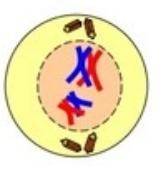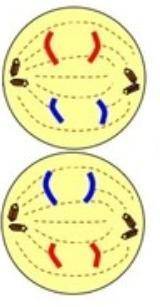
What phase does not occur between meiosis I and meiosis II, which results in haploid daughter cells?
A:Interphase
B:Prophase
C:Anaphase
D:Cytokinesis
The model below represents a phase of meiosis. What stage of meiosis does the picture below represent?
A:prophase I
B:prophase II
C:anaphase I
D:anaphase II
Which letter represents a single chromatid?
A:A
B:B
C:C
D:None of the above
Which letter represents the chromosome?
A:A
B:B
C:C
D:None of the above
Which letter represents the centromere?
A:A
B:B
C:C
D:None of the above
The model below represents a phase of meiosis. What stage of meiosis does the picture below represent?
A:anaphase II
B:metaphase II
C:prophase I
D:telophase I




Answers: 1


Other questions on the subject: Biology

Biology, 22.06.2019 04:30, Tnaaasty5901
Pls quickly! which of the following is true about the behavior of an organism? a. the behavior of an organism is influenced by both its heredity and it’s environment. b. the behavior of an organism is influenced only by the treats it inherits from its parents. c. the behavior of an organism is influenced only by the environment in which it lives in. d. the behavior of an organism is not influenced by either it’s heredity or its environment.
Answers: 2

Biology, 22.06.2019 06:50, Shaylaharrison15
The kidney filters potentially toxic substances in the blood, and thus “clears” the blood of those substances. this clearance function is dependent upon and proportional to the diffusion gradient of the substance across filtering capillaries, i. e. if the concentration of the substance is doubled, twice as much will be cleared from each ml of blood that is filtered. suppose that the body produces a constant amount of a substance x per unit of time. the kidneys eliminate substance x at a rate directly proportional to the concentration of the substance and the volume of blood cleared each minute (c): elimination = c × [x], where [x] is the steady-state concentration of substance x. imagine an individual with an initial concentration of x equal to [x]0 who develops kidney disease. her baseline clearance c0 drops to one half of the original (½c0). what is the new steady state concentration of x? (for simplicity, assume that substance x is 100% filtered by the kidney).
Answers: 1


Biology, 22.06.2019 12:30, musa79
Which of the following observation darwin shape his concept of descent with modification? a) species diversity declines farther from the equator. b) fewer species live on islands than on the nearest continents. c) birds live on islands located farther from the mainland than the bird's maximum nonstop flight distance. d) south american temperate plants are more similar to the tropical plants of south america than to the temperate plants of europe. e) earthquakes reshape life by causing mass extinctions.
Answers: 1
You know the right answer?
What phase does not occur between meiosis I and meiosis II, which results in haploid daughter cells?...
Questions in other subjects:



Mathematics, 09.09.2020 03:01


English, 09.09.2020 03:01








